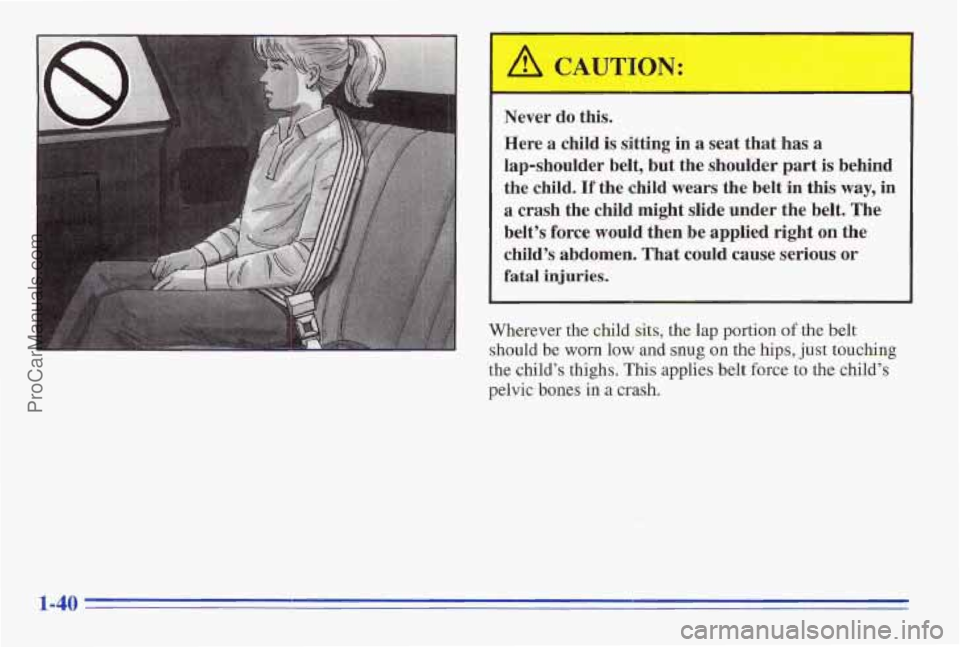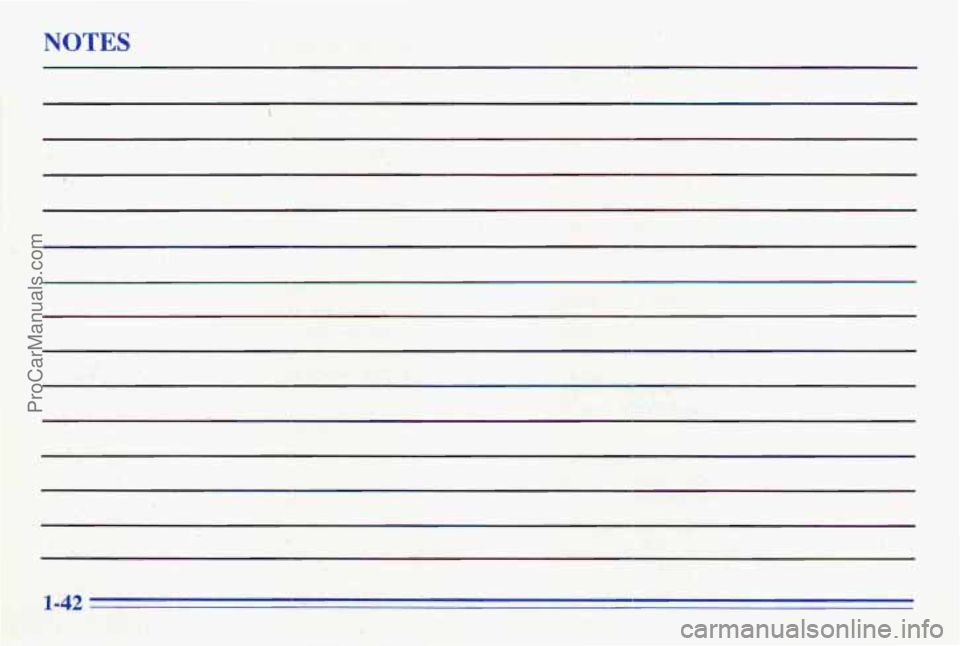PONTIAC FIREBIRD 1996 Service Manual
Manufacturer: PONTIAC, Model Year: 1996, Model line: FIREBIRD, Model: PONTIAC FIREBIRD 1996Pages: 386, PDF Size: 19.18 MB
Page 41 of 386

Securing a Child Restraint in a
Rear Seat Position
You’ll be using the lap-shoulder belt: See the earlier part
about the top strap if the child restraint has, one.
1. Put the restraint on the seat. Follow the instructions
hr the child restraint.
2. Secure the child in the child restraint as the
instructions say.
3. Pick up the latch plate, and run the lap and shoulder
portions
of the vehicle’s safety belt through or
around the restraint. The child restraint instructions
.will shw you how.
Tilt’the latch plate to adjust the belt if needed.
If the shoulder b’elt goes in front of the child’s face or
neck, put it behind the child restraint.
1-34
ProCarManuals.com
Page 42 of 386

4. Buckle the belt. Make sure the release button is
positioned
so you would be able to unbuckle the
safety belt quickly
if you ever had to.
5. To tighten the belt, pull up on the shoulder belt while
you push down on the child restraint.
6. Push and pull the child restraint in different
directions
to be sure it is secure.
To remove the child restraint, just unbuckle the vehicle’s
safety belt and let it go back all the way. The safety belt
will
move freely again and be ready to work for an adult
or larger child passenger.
1-35
ProCarManuals.com
Page 43 of 386

Securing a Child Restraint in me
Right Front Seat Position
Your vehicle has a right front passenger air bag. Never
put a rear-facing child restraint in this seat. 1 :e’s why:
A
child in a rear-facing child restraint can be
seriously injured if the right
front passenger’s air
bag inflates, This is because the back of a
rear-facing chiId
restraint would be very close to
the inflating air
bag. Always secure a rearfacing
child restraint in the rear seat.
You’ll be using the lap-shoulder belt. See the earlier part
about the top strap if the child restraint has one.
1. Because your vehicle has a right front passenger air
bag, always move the seat as far back as it will go
before securing a forward-facing child restraint.
(See “Seats”
in the Index.)
2. Put the restraint on the seat. Follow the instmctions
for
the child restraint.
3. Secure the child in the child restraint as the
instructions sqy.
4. Pick up the latch plate, and run the lap and shoulder
portions of the vehicle’s safety belt through or
around the restraint. The child restraint instructions
will show you how.
ProCarManuals.com
Page 44 of 386

Tilt the latch plate to adjust the belt if needed.
If the shoulder belt goes in front of the child’s face or
neck, put it behind the child restraint.
5. Buckle the belt. Make sure the release button is
positioned
so you would be able to unbuckle the
safety belt quickly if you ever had to.
1-37
ProCarManuals.com
Page 45 of 386

6. To tighten the belt, pull up on the shoulder belt while
you push down on the child restraint.
7. Push and pull the child restraint in different
directions to be sure it is secure.
To remove the child restraint, just unbuckle the vehicle’s
safety belt and let it
go back all the way. The safety belt
will move freely again and be ready
to work for an adult
or larger child passenger.
Larger Childrc i
Children who have outgrown child restraints should
wear the vehicle’s safety belts.
1-38
ProCarManuals.com
Page 46 of 386

Accident statistics show that children are safer if they
are restrained in the rear seat. But they need to use the
safety belts properly.
Children who aren’t buckled up can be thrown out in
a crash;
people who
are.
Children who aren’t buckled up can strike other
I I
Never do this.
Here two children are wearing the same belt. The
belt can’t properly spread the impact forces. In a
crash, the two children can be crushed together
and seriously injured.
A belt must be used by
only one person at a time.
&.’ What if a child is wearing a lap-shoulder belt,
but the child
is so small that the shoulder belt is
very close to the child’s face or neck?
A: Move the child toward the center of the vehicle, but
be sure that the shoulder belt still
is on the child’s
shoulder,
so that in a crash the child’s upper body
would have the restraint that belts provide.
ProCarManuals.com
Page 47 of 386

Never do this.
Here a child is sitting in a seat that has a
lap-shoulder belt, but the shoulder part
is behind
the child.
If the child wears the belt in this way, in
a crash the child might slide under the belt. The
belt’s force
wodd then b’e applied right on the
child’s abdomen. That could cause serious
or
fataligjuries.
Wherever the child sits, the lap portion of the belt
should
be worn low and snug on the hips, just tou’ching
the child’s thighs. This applies belt force to the child’s
pelvic bones in a crash.
ProCarManuals.com
Page 48 of 386

Safety Belt Extender
If the vehicle’s safety belt will fasten around you, you
should use it.
But if a safety belt isn’t long enough to fasten,, your
1 dealer will order you an extender. It’s free. When you go
in to order it, take the heaviest coat you will wear, so the
extender
will be long enough for you. The extender will
‘be just for you, and just for the seat in your vehicle that
you choose. Don’t let someone else use it, and use it
only for the seat
it is made to fit. To wear it, just attach it
to the regular safety belt.
Checking Your Restraint Systems
NOW and then, make sure the safety belt reminder light
and all your belts, buckles, latch plates, retractors and
anchorages are working properly. Look for any other
loose or damaged safety belt system parts. If you see
anything that might keep a safety belt system from
doing its job, have it repaired.
Torn or frayed safety belts may not protect you in a
crash. They can rip apart under impact forces. If a belt is
torn
01‘ frayed, get a new one right away.
Ah look for any opened or broken air bag covers, and
have them repaired or replaced. (The air bag system
does not need regular maintenance.)
Replacing Restraint System Parts
After
a Crash
If you’ve had a crash, do you need new belts?
After
a very minor collision, nothing may be necessary.
But
if the belts were stretched, as they would be if wm
during a more severe crash, then you need new belts.
If belts are cut or damaged, replace them. Collision
damage also may mean you will need to have safety belt
or seat parts repaired
or replaced. New parts and repairs
may be necessary even if the belt wasn’t being used at
the time of the collision.
If
an air bag inflates, you’ll need to replace air bag
system
parts. See the part on the air bag system earlier in
this section.
i
1-41
ProCarManuals.com
Page 49 of 386

NOTES
1-
ProCarManuals.com
Page 50 of 386

v Section 2 Features and Controls
Here you can learn about the many standard and
optional features on your Pontiac, and information on
starting, shifting and braking.
Also explained are the
instrument panel and the warning systems that tell you
if
everything is working properly -- and what to do if you
have a problem.
Keys
1
Leaving young children in'a vehicle with the
ignition key is dangerous for many reasons.
A child or others could be badly injured or
even killed.
They could operate power windows or other
controls or even make
the vehicle move. Don't
leave the keys in a vehicle
with young children.
I I
2-1
ProCarManuals.com